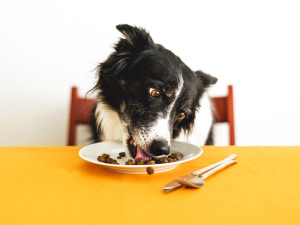How Many Times Should You Really Be Feeding Your Dog a Day?
Experts weigh in on whether eating once or twice is better for health and longevity.

Share Article
Over the last decade, intermittent fasting has become one of the trendiest terms in health and wellness circles. The simple strategy of decreasing how often you eat each day, as opposed to necessarily how much, is an enticing proposition for those wanting to lose weight. I myself stick to an eight-hour eating window, though it’s mostly just to combat my utterly endless and frankly disgusting appetite. But many experts also promote the eating plan’s benefits beyond dropping pounds, noting its impact on brain health and how the body operates overall.
Now it appears that dogs may benefit from a similar regimen. While human fasting usually involves going from a standard three-meal structure to a two-meal one, we might want to consider dropping our pups down to once a day. Before I start getting angry emails from dogs everywhere, it’s important to point out there is research to support this concept. At least, preliminarily.
Eating once a day keeps the vet away?
In 2022, researchers with the Dog Aging Project examined how time-restrictive diets influence canine mental and physical health. By using data that they collected from nearly 25,000 dogsopens in new tab — each of varying breeds, sizes, and ages — the team assessed cognitive function and health conditions in connection with eating frequency. Only about eight percent of pet parents reported feeding their animals once a day, while just under 75 percent fed them twice. The rest were fed three or more times.
Ultimately, the researchers found that dogs fed once daily performed better on their survey which measured cognitive function. They were also less likely to develop gastrointestinal, dental, orthopedic, kidney, or liver issues and diseases. Of course, the study carries one massive caveat, being that the vast majority of those involved ate two or more times every day. The authors themselves note this flaw in their findings.

Still, the study suggests that, at a minimum, that once-a-day feeding is worthy of additional research and possibly consideration from pet parents. Dr. Sam Meisler, veterinarian and founder of PetWellClinicopens in new tab, explains that this meal plan does have roots in nature.
“Once-a-day feeding is not unlike how dogs ate in the wild so there is in all likelihood an evolutionary component to this choice,” he says before adding that such a strategy could be better for their digestive tract as a result.
So, how many times a day should I feed my dog?
This, of course, operates counter to the conventional wisdom that dogs should be fed twice each day. However, Dr. Meisler adds some caution to the trendy concept, confirming that there is no definitive eating strategy ideal for all dogs. “It is important to always keep in mind, each dog is different. There is no one-size-fits-all. Each dog’s individual needs vary based on their unique circumstances,” he says.
When determining how often to feed your pup, their health, age, daily activity, and breed should be your main considerations. According to Dr. Meisler, puppies and senior dogs usually require more frequent feeding due to specific nutritional needs associated with those stages of life.
Similarly, dogs with certain health conditions, like diabetes, may also benefit from smaller, more frequent meals. On the other hand, Dr. Meisler recommends spreading out meals for larger breeds to avoid common conditions, like gastric bloat. He notes that more active dogs should also stick to a two-meal structure to enjoy a steady supply of energy throughout the day.
Quantity over frequency
All that being said, the number of times you’re feeding your dog each day shouldn’t be your main dietary concern. Instead, it seems the equation of how much to feed them is far more important than how often. Think of it this way: if I only ate once every day but that one meal was $60 worth of McDonald’s, I don’t think I’d make it to age 40. The risks of malnutrition and overeating are the same whether a dog eats once or four times every day. Be warned, this risk is especially high for certain breeds as Dr. Meisler explains.
“For example, flat-nosed or brachycephalic breeds can struggle with severe breathing problems, and being overweight can exacerbate this problem. They can also be more susceptible to heat stroke so it is important they maintain a healthy weight,” he says. Common brachycephalic breeds include Bulldogs, Frenchies, Pugs, Shih Tzus, or pretty much any pup whose face looks adorably smooshed. Dr. Meisler adds that Dachshunds are uniquely susceptible to back problems, a risk that intensifies once overweight. Other breeds, like Labradors, are prone to osteoarthritis and this too will be heightened by excess weight due to extra wear and tear put on their joints.
But for any breed, obesity will help breathing problems, diabetes, and osteoarthritis develop. “Obesity is the most common health problem in dogs, and it can contribute to diabetes, heart disease, respiratory issues, and decreased liver function. Excess weight also puts more stress on joints, leading to arthritis and reduced mobility, resulting in a sedentary lifestyle. Overweight dogs tend to have shorter lifespans,” Dr. Meisler warns.
Making matters worse is the fact that this sedentary lifestyle can create a vicious cycle of obesity that’s hard to break. Overweight dogs, in general, are less likely to play or exercise. Not only does this negatively impact their mental health but it will inevitably lead to more weight gain. That’s to say nothing of how these snowballing health issues will influence your wallet thanks to increased veterinary expenses.
Correction: How much should I feed my dog?
And if you’re thinking none of this is a concern because you keep your pup on a strict low-cal diet, don’t worry, I promise I can stress you out, too! Per Dr. Meisler, underfeeding your pet comes with its own laundry list of risks. “Insufficient calories lead to vitamin deficiencies, negatively impacting your dog’s health. Lack of proper nutrition can weaken their immune system. Their muscles waste away reducing strength and mobility,” he says.
When dogs are perpetually hungry, they may begin to act anxious and irritable, possibly leading to aggressive behaviors surrounding food. For puppies, underfeeding can even stall growth and combat their healthy development.
Ultimately, if any dog fails to receive adequate nutrition, their body might slowly shut down on them. “Vital organs like the liver and kidneys can be impacted, impairing their ability to filter toxins and properly perform. The heart muscle can be weakened if essential nutrients are lacking, leading to cardiovascular issues,” Dr. Meisler warns.
With all of that in mind, exactly how much to feed our pets is the natural next question. While Dr. Meisler notes that the guidelines often presented on food bags are a good place to start, they’re still a flawed metric. Again, every dog is different, so every dog has different needs. Daily activity and the number of calories your dog regularly burns are the best indicators of the amount of food they should consume according to Dr. Meisler. But breed, size, and age are all factors as well. If you’re unsure, it’s never a bad idea to chat with your primary vet.
More than anything, you want to ensure whatever they’re eating is nourishing and appropriately portioned. As Dr. Meisler puts it, “Remember, a balanced, healthy diet for your dog is like a good walk. It’s necessary, restorative, and keeps the tail wagging.”

Sean Zucker
Sean Zucker is a writer whose work has been featured in Points In Case, The Daily Drunk, Posty, and WellWell. He has an adopted Pit Bull named Banshee whose work has been featured on the kitchen floor and whose behavioral issues rival his own.
Related articles
![Grey cat at looking up from eating on floor at home]()
Gut Feelings: How to Balance Your Pet’s Microbiome
The mind-gut connection isn’t just for people. Your dog or cat’s gut microbiome plays a big role in their health and well-being.
Can Adult Dogs Eat Puppy Food?
They might still be your baby, but here’s why they need to eat like a grown-up.
![Cute dog dining with people during the evening light on the backyard of the house outdoors.]()
Labs Are Actually Hungrier Than Other Dogs, New Study Finds
Being constantly starving is in their genes.
![Small brown puppy chewing on plastic donut toy.]()
Toys Containing BPA May Cause Obesity in Dogs, New Study Finds
The chemical has been linked to a variety of health problems in animals.
![Woman measuring dog food with scale]()
Should You Put Your Dog on a Low-Calorie Diet?
Diet culture is a tricky thing — for pets, too.
![Man crouching down to let two dogs eat out of a bowl]()
How Many Treats Is Too Many?
The key to curbing mindless snacking — this is for your dog.









